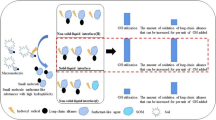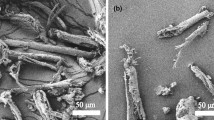Abstract
Commercially available alkyl alcohol ethoxylates have a broad distribution of ethylene oxide (EO) units and also a somewhat narrower distribution of alkyl chain length. Generally, the purer the surfactant sample (narrower distribution), the better is its detergency performance, and detergency peaks at the phase inversion temperature (PIT) for a given oil. However, in real detergency processes this may not hold true since soils are typically mixtures of several oily components, and temperature variations are significant. Therefore, if a polydispersity index (PDI) of ethoxylates is defined as the ratio of weight average EO moles to number average EO moles in the sample, then it is conceivable that an optimal PDI might be obtained. We compared the detergency of hexadecane for pentaethylene glycol monododecyl alcohol (C12EO5) samples in a broad PDI range, using an oil-soluble dye. While detergency at 55°C (PIT of hexadecane with C12EO5) decreases monotonically with increasing creasing PDI, average detergency over a 20°C temperature range around the PIT tends to show a maximum at PDI of ca. 1.1 (narrow-range ethoxylate). Similarly, for a mixture of undecane/hexadecane/tetracosane (30∶50∶20 w/w/w) for which the average PIT is approximately the same as that of hexadecane detergency at 55°C shows a maximum as a function of PDI at a value of ∼1.37 (broad-range ethoxylate). All detergency results are in general agreement with the reverse trends in oil/water interfacial tension and suggest that, having decided the optimal EO moles for a given application based on PIT, one can further improve the performance of alcohol ethoxylates in real detergency processes by tuning their polydispersity.
Similar content being viewed by others
References
Kahlweit, M., and R. Strey, The Phase Behavior of H2O-Oil-Nonionic Amphiphile Ternary Systems, in Microemulsion Systems, edited by H.L. Rosano and M. Clausse, Vol. 24, Surfactant Science Series, Marcel Dekker Inc., New York, 1987, pp. 1–13.
Raney, K.H., Optimization of Nonionic/Anionic Surfactant Blends for Enhanced Oily Soil Removal, J. Am. Oil Chem. Soc. 68:525–531 (1991).
Raney, K.H., W.J. Benton, and C.A. Miller, Optimum Detergency Conditions with Nonionic Surfactants: I—Ternary Water-Surfactant-Hydrocarbon Systems, J. Colloid Interface Sci. 117:282–290 (1987).
Thompson, L., The Role of OII Detachment Mechanisms in Determining Optimum Detergency Conditions, 163:61–73 (1994).
Nico, M. van Os (ed.), Nonionic Surfactants—Organic Chemistry, Surfactant Science Series, Vol. 72, Marcel Dekker, New York, 1998.
Goel, S.K., Measuring Detergency of Oily Soils in the Vicinity of Phase Inversion Temperatures of Commercial Non-ionic Surfactants Using an Oil-soluble Dye, J. Surfactants Deterg. 1: 221–226 (1998).
Goel, S.K., Selecting the Optimum Linear Alcohol Ethoxylate for Enhanced Oily Soil Removal,, 1:213–219 (1998).
Cox, M.F., The Effect of ‘Peaking’ the Ethylene Oxide Distribution on the Performance of Alcohol Ethoxylates and Ether Sulfates, J. Am. Oil Chem. Soc. 67:599–604 (1990).
Hreczuch, W., G. Bekierz, and J. Szymanowski, Homologue Distribution of Alcohol Ethoxylates, Tenside Surfactants Deter. 32:55–60 (1995).
Dillan, K.W., Effects of the Ethylene Oxide Distribution on Nonionic Surfactant Properties, J. Am. Oil Chem. Soc. 62:1144–1151 (1985).
Smith, D.L., Comparison of Salt Thickening of Conventional and Peaked Alcohol Ether Sulfates, 68:629–633 (1991).
Garcia, M.T., I. Ribosa, J. Sanchez Leal, and W. Hreczuch, Effect of Homologue Distribution on the Toxicity of Alcohol Ethoxylates, 73:903–906 (1996).
Hanna, I., Novel Nonionics from Oleochemicals, INFORM 8:628–636 (1997).
Shinoda, K., H. Saito, and H. Arai, Effect of Size and Distribution of Oxyethylene Chain Lengths of Nonionic Emulsifiers on the Stability of Emulsions, J. Colloid Interface Sci. 35:624–630 (1971).
Kissa, E., Kinetics and Mechanisms of Soiling Detergency, in Detergency: Theory and Practice, edited by W.G. Cutler and E. Kisssa, Surfactant Science Series, Vol. 20, Marcel Dekker, New York, 1987, p. 258.
Young, R.J., Introduction to Polymers, Chapman and Hall, New York, 1989, pp. 4–8.
Allen, M.C., and D.E. Linder, Ethylene Oxide Oligomer Distribution in Nonionic Surfactants via High-Performance Liquid Chromatography (HPLC), J. Am. Oil Chem. Soc. 58:950–957 (1981).
Kissa, E., Evaluation of Detergency, in Detergency: Theory and Practice, edited by W.G. Cutler and E. Kisssa, Surfactant Science Series, Vol. 20, Marcel Dekker Inc., New York, 1987, p. 64.
Rosen, M.J., Surfactants and Interfacial Phenomena, 2nd edn., John Wiley $ Sons, New York, 1989, p. 286.
Schick, M.J., Non ionic Surfactants—Physical Chemistry, Surfactant Science Series, Vol. 23, Marcel Dekker Inc., New York, 1987, pp. 123–127.
Arai, H., and K. Shinoda, The Effect of Mixing of Oils and of Nonionic Surfactants on the Phase Inversion Temperatures of Emulsions, J. Colloid Interface Sci. 25:396–400 (1967).
Author information
Authors and Affiliations
Corresponding author
About this article
Cite this article
Goe, S.K. Tuning the polydispersity of alcohol ethoxylates for enhanced oily soil removal. J Surfact Deterg 1, 539–545 (1998). https://doi.org/10.1007/s11743-998-0056-9
Received:
Accepted:
Issue Date:
DOI: https://doi.org/10.1007/s11743-998-0056-9




